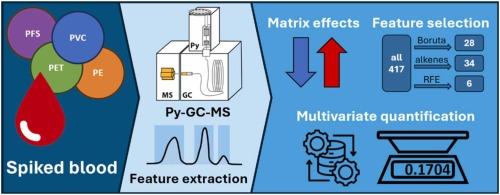Improved multivariate quantification of plastic particles in human blood using non-targeted pyrolysis GC-MS
IF 12.2
1区 环境科学与生态学
Q1 ENGINEERING, ENVIRONMENTAL
引用次数: 0
Abstract
Accurate analytical methods are crucial to assess human exposure to micro- and nanoplastics (MNPs). Quantitative pyrolysis-gas chromatography coupled with mass spectrometry (Py-GC-MS) has recently been used for quantifying MNPs in human blood. However, pyrolysis introduces complex effects such as secondary reactions between matrix compounds and polymers. This work introduces a non-targeted and multivariate approach to improve the identification and quantification of polyethylene (PE), poly(vinyl chloride) (PVC) and polyethylene terephthalate (PET). After spiking of extracted blood samples, PARADISe was used for componentization and integration of 417 features detected with Py-GC-MS. Quantification based on multivariate calibration models demonstrated a superior performance when compared to univariate regression. Feature selection approaches were used to identify optimal feature subsets, which reduced quantification errors by 30% for PE, 10% for PVC and 38% for PET. In addition, chemical insight into pyrolysis processes was obtained by studying the matrix effects (MEs) of blood. The pyrolysis of PE and PVC appeared to be minimally affected (MEs=81%-154%), while PET exhibited complex interactions with the matrix (MEs=40%-9031%), impacting its quantification accuracy. In conclusion, this research highlights the importance of accounting for secondary effects during pyrolysis and introduces a multivariate approach for more accurate and robust quantification of MNPs in blood.

求助全文
约1分钟内获得全文
求助全文
来源期刊

Journal of Hazardous Materials
工程技术-工程:环境
CiteScore
25.40
自引率
5.90%
发文量
3059
审稿时长
58 days
期刊介绍:
The Journal of Hazardous Materials serves as a global platform for promoting cutting-edge research in the field of Environmental Science and Engineering. Our publication features a wide range of articles, including full-length research papers, review articles, and perspectives, with the aim of enhancing our understanding of the dangers and risks associated with various materials concerning public health and the environment. It is important to note that the term "environmental contaminants" refers specifically to substances that pose hazardous effects through contamination, while excluding those that do not have such impacts on the environment or human health. Moreover, we emphasize the distinction between wastes and hazardous materials in order to provide further clarity on the scope of the journal. We have a keen interest in exploring specific compounds and microbial agents that have adverse effects on the environment.
 求助内容:
求助内容: 应助结果提醒方式:
应助结果提醒方式:


